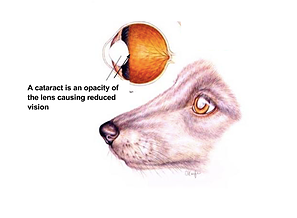 A cataract is an opacity (cloudy area) within the lens of the eye. Cataract size can range from small to large. Small cataracts minimally alter vision, whereas larger cataracts can result in blindness.
A cataract is an opacity (cloudy area) within the lens of the eye. Cataract size can range from small to large. Small cataracts minimally alter vision, whereas larger cataracts can result in blindness.
Cataracts are very common and can occur for a variety of reasons, including:
- Congenital (born with cataracts)
- Genetic (born with predisposition to form cataracts)
- Age related
- Diabetes
- Trauma
- Dietary deficiencies
Although cataracts are considered benign, there are still concerns or complications that can arise as a result of a pet having cataracts. These include:
- Decreased vision/blindness
- Lens luxation (lens can become loose in the eye causing damage)
- Uveitis (inflammation of the inner eye)
- Glaucoma (occurs secondary to inflammation)
Treatment of cataracts is not always warranted. If the cataract is small and uncomplicated, no treatment is needed. Treatment is warranted if a cataract causes blindness, luxates, or if it results in inflammation or glaucoma of the eye. Treatment options include:
- Minor episodes of inflammation of the eye secondary to cataracts can be treated with prescription anti-inflammatory eye drops.
- Surgical removal of cataract with or without artificial lens placement
- Phacoemulsification (breaking apart the lens with sound waves)
- Enucleation (removal of the entire eye) may be needed in cases with glaucoma
- Although there are over the counter eye drops claiming to “treat” or “cure” cataracts these products DO NOT WORK

